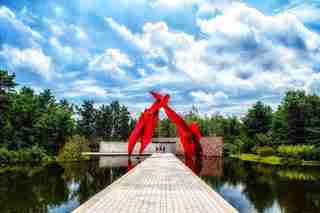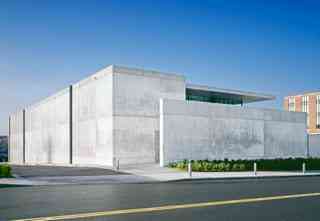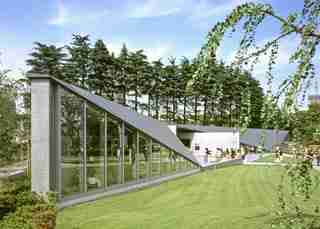
Born in 1941, Tadao Ando is a self-taught architect whose minimalist aesthetic and love of natural materials like glass and concrete earned him the Pritzker Prize in 1995. His buildings are marked by a masterful command of the elements, including natural light that diffuses into interiors at just the right angles, pools of water that reflect his angular designs, and ventilation methods that mimic human breathing. Because of this, Ando’s structures are actually quite complex, despite their simple appearance and affinity for preserving open space. An icon of Japanese culture, Ando has constructed most of the buildings in his oeuvre in his native country, and even donated his Pritzker Prize money to orphans of the 1995 Kobe earthquake. What follows is a selection of Ando’s most notable works—remarkable not only for their aesthetics but also for their thoughtfulness and concern for the people they host.
Shown: Built on a peak in South Korea’s Daegwallyeong mountain range, the Hansol Museum is a modular structure made with local limestone. In addition to its extensive modern art collection, the building hosts Archway by Alexander Liberman over the pathway to its entrance. Finished in 2013, the museum is also surrounded by a tiered water garden.

Walls of concrete and glass form the serene Pulitzer Arts Foundation in St. Louis. Commissioned by Emily Rauh Pulitzer, art patron and granddaughter-in-law to the famous Joseph Pulitzer, this museum opened in 2001 and features artworks from the prestigious family’s private collection. In 2014 the museum underwent renovations, overseen by Ando, to create two new public galleries.

Built in collaboration with fashion designer Issey Miyake, the 21 21 Design Sight museum features a steel roof inspired by Miyake’s “A Piece of Cloth” concept, which explores the relationship between the human body and clothing. Located in Tokyo, the split-level building with glass walls is meant to act as a space for the examination of how design impacts daily life. The museum was completed in 2007.
The Stone Hill Center, completed in 2008, is an art gallery and educational space at the Sterling and Francine Clark Art Institute in Williamstown, Massachusetts. The east end of the building, shown here, is a visually linear structure made with concrete, steel, glass, and wood.
The Hyōgo Prefectural Museum of Art, located in southern Japan, houses sculptures, prints, and paintings, some relating to the earthquake that devastated the region in 1995. The concrete structure, in Ando’s signature minimalist style, officially opened in 2002.
This drum-shaped building, with an adjacent rectangular structure, is the Suntory Museum in Osaka, Japan, completed in 1994. Commissioned by the Japanese liquor brand Suntory, the museum is actually a cultural complex, with a cinema, shopping area, and restaurant in addition to gallery space.
Completed in 2002, the Modern Art Museum of Fort Worth in Texas is a glass, metal, and concrete building that was designed to filter natural light into the interior spaces. The structure is surrounded by a reflecting pool, as well as 11 acres of lush green land.
Designed with a gently arched roof, the glass-walled Naniwabashi Station is a transit center in Osaka, Japan. The station, which opened to the public in 2008, is adjacent to other cultural landmarks, including a park, library, and museum.
Commissioned by François-Henri Pinault, CEO of the French luxury conglomerate Kering, Ando restored and renovated Venice’s Punta della Dogana art museum in 2009. Situated at the intersection of the Grand Canal and Giudecca Canal, the structure is the city’s former customs building.
While the exterior of the Venice museum was merely repaired, the interior is where Ando’s genius shines. The architect reimagined the space in his characteristic minimalist style, leaving the brickwork exposed, finishing the floors with polished concrete, and adding glass and steel elements. The result is an open, airy space that allows the art to take precedence.
Made with glass and concrete, the Museum of Literature in Himeji, Japan, is home to the writings of Japanese philosopher Tetsuro Watsuji and eight local writers. Entry to the museum is provided by a ramp that gently ascends over tiered pools of water lined with crushed rocks.The main building was completed in 1991, and the annex, featuring the works of writer Ryotaro Shiba, was completed in 1996.
This origami-like building made with black steel is HH Style/Armani Casa, a temporary structure built in Tokyo in 2005 as a collaboration between Ando, the Japanese online home shop hhstyleom, Armani Casa, and the kitchen-and-bath company Boffi. The angular space, used as a showroom for its three patron brands, featured a corrugated white metal interior with an open, airy feel.
Omotesando Hills, a shopping and residential complex in Tokyo, was completed in 2005. Already located on the city’s most fashionable street for retail, the building has space for 130 stores, most of them underground, illuminated by natural light from the atrium above. The building, which sits opposite a grove of zelkova trees, has a translucent glass façade fitted with colorful LED displays.
Opened in 2008, Shibuya Station is a transit hub in the Tokyo’s namesake shopping district. Famous for its central atrium, a lofty space with an elliptical shape, the station is also remarkable for its “breathing” properties—the hot air from trains rises up through the atrium while cool air from the ground floor flows in, creating a natural cycle of ventilation to make daily commutes more comfortable.

Leave a Reply